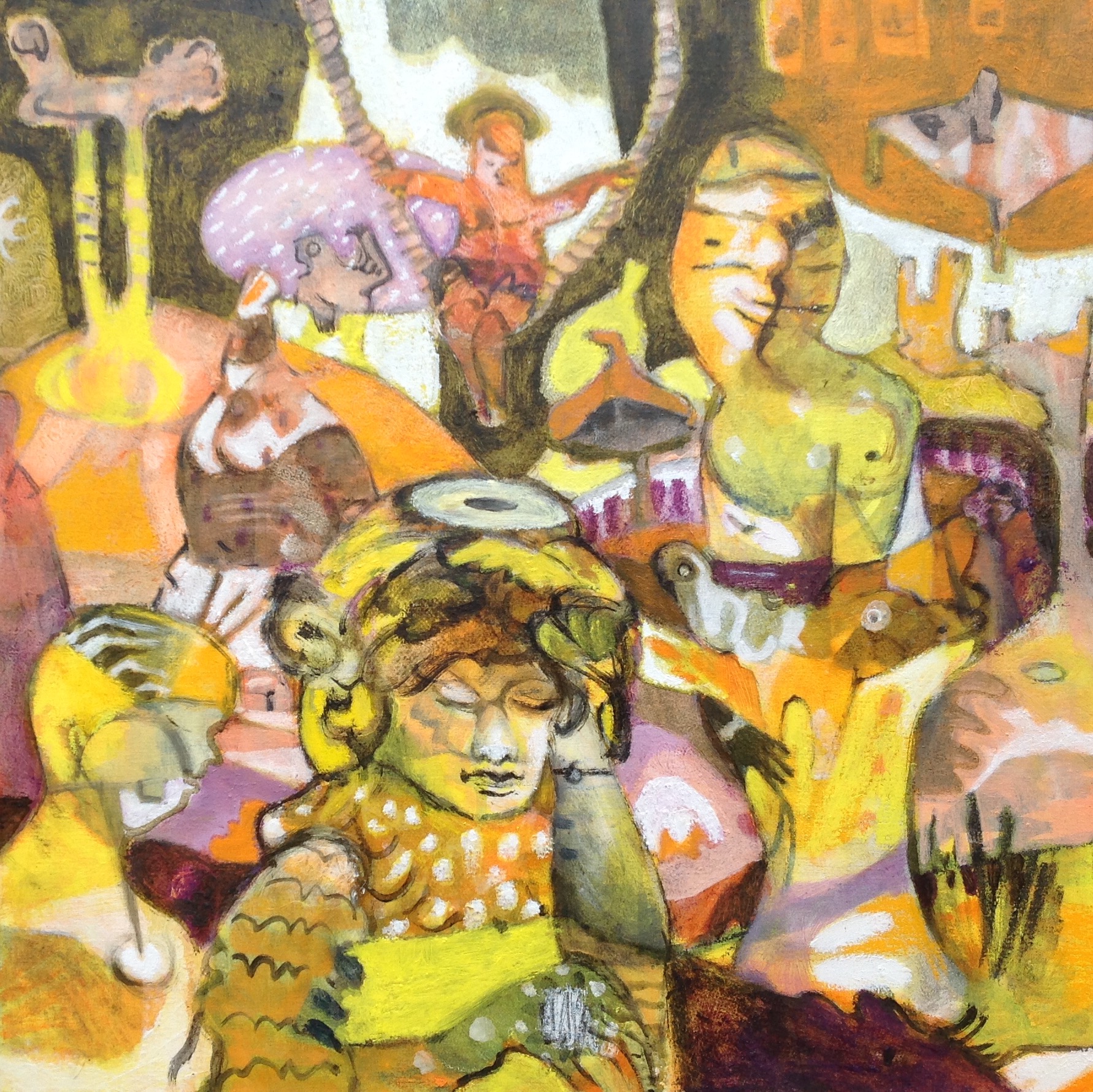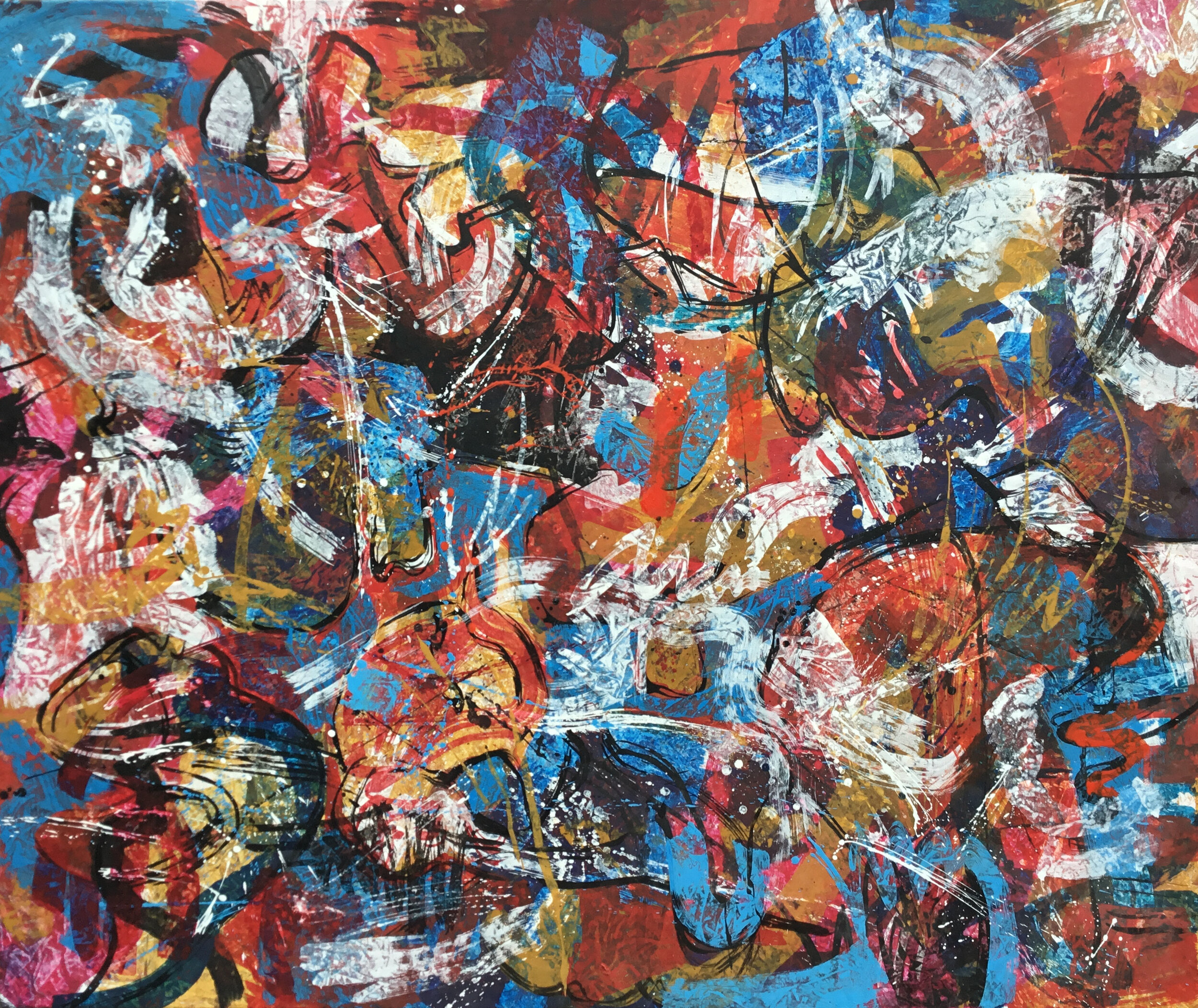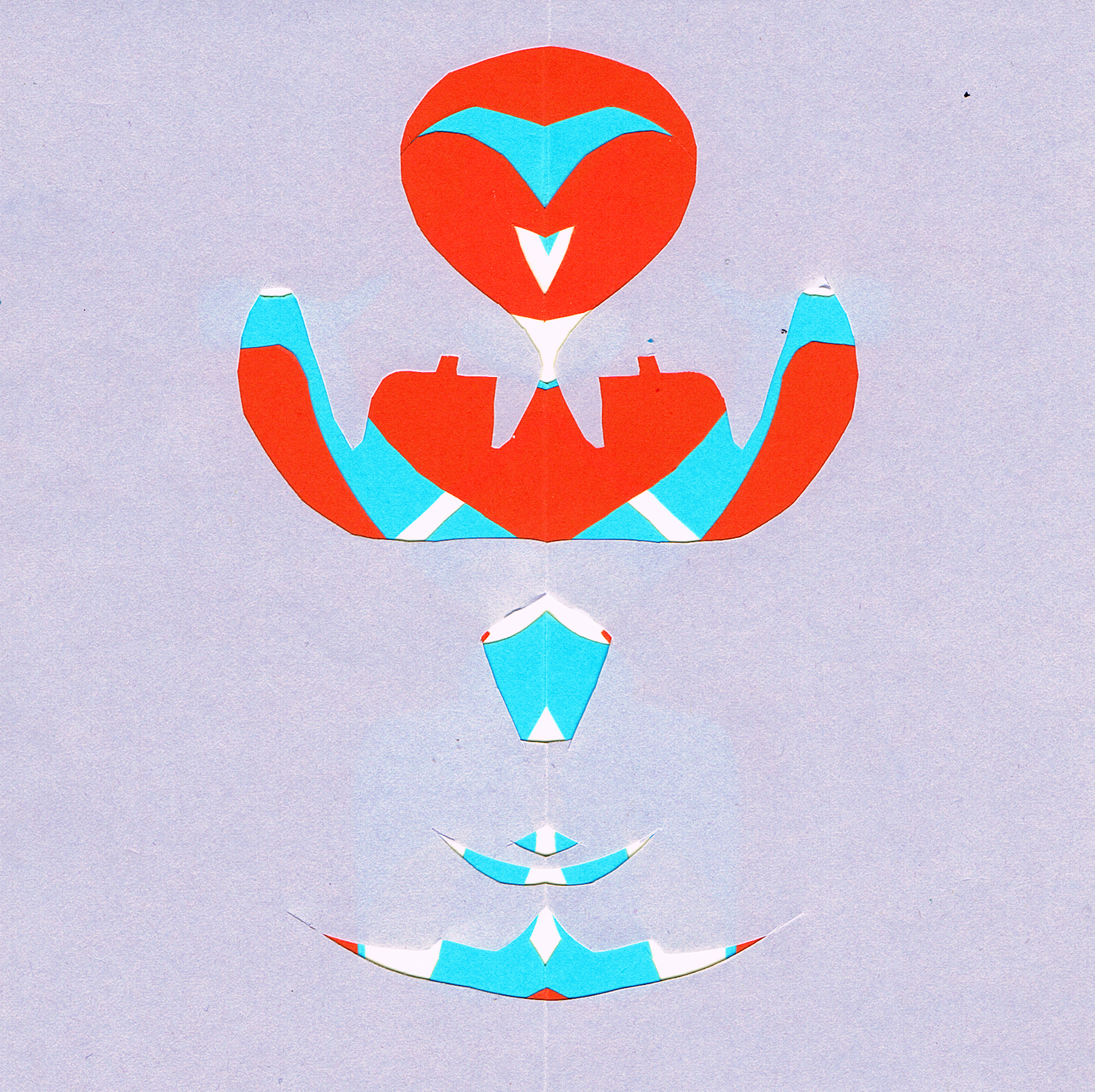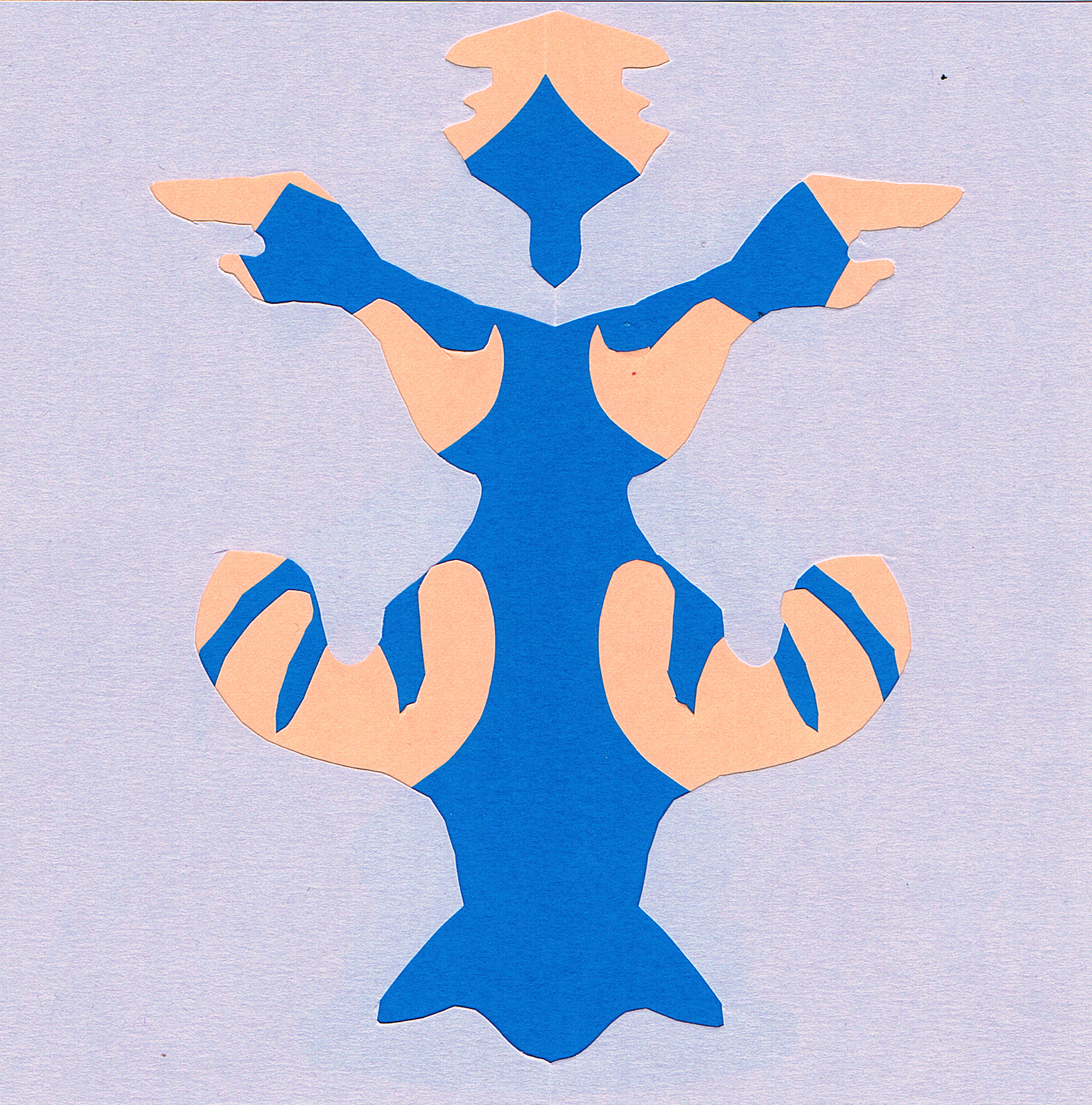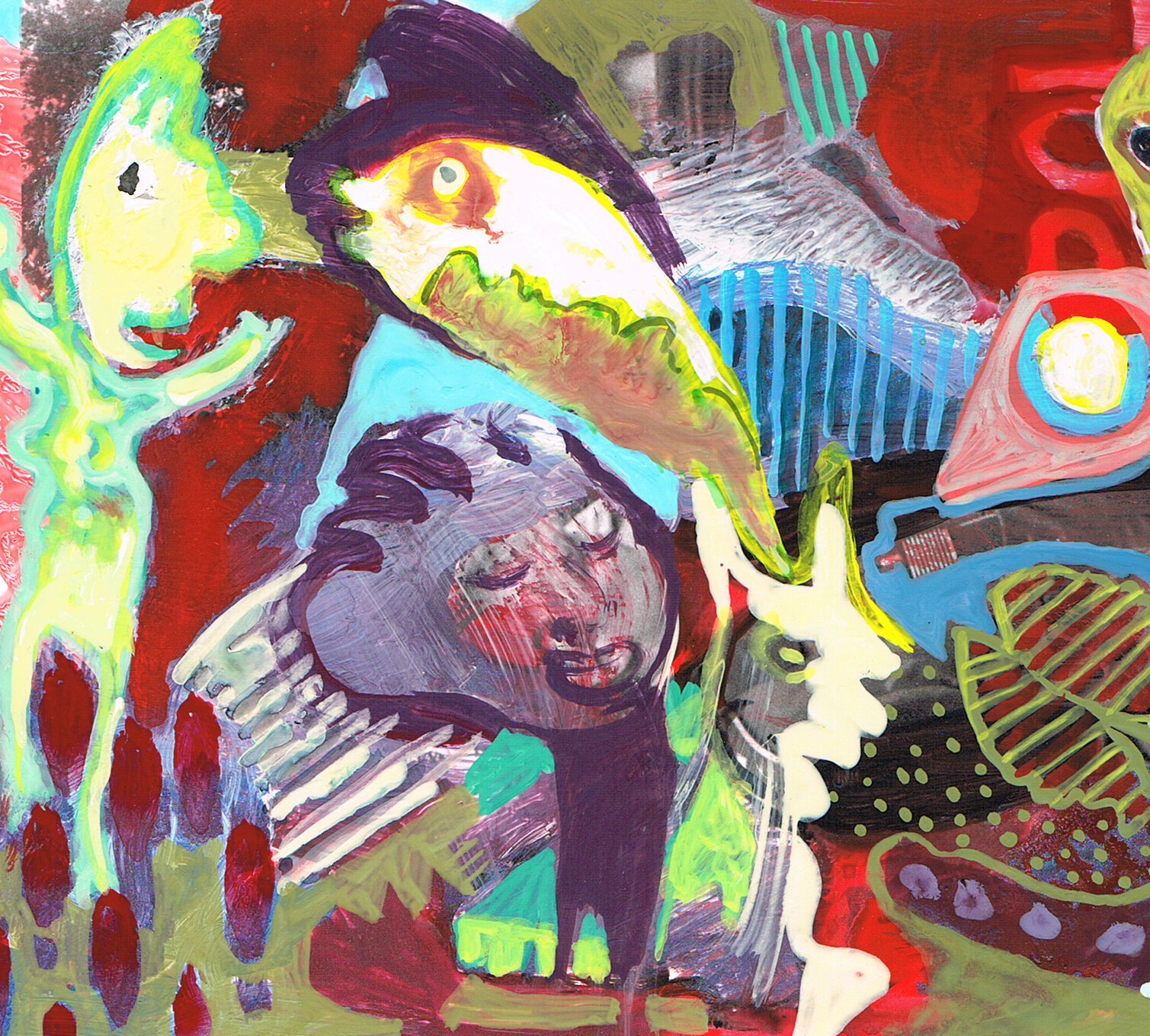








Visual Art
by Annette Falk Lund
Visual Art
by Annette Falk Lund
Join me in the undergrowth of imagination
Most of my work consists of oil and gouache painting on coarse canvas and limestone paper. I’m obsessed with narratorial and mystical, inviting motives and figures, but I also dwell in abstractions, that derive their attraction from the interplay between lines and colors.
Drawings, both as external sketches and integral elements, serve as a central set of tools, that I use to elaborate on the theme of each painting.
To work with narratorial motifs is a kind of soliloquy (“Selbstgespräch”) for me. The improvisational character of my method is perhaps best described like this:
a brush dipping into a glass of water
an oilstick losing its way on the vast canvas
a piece of cloth kissing the paper’s surface
gouache dripping from my hand, meeting its fate
constant agitation. exploratory. with no destination in mind
The result is an allegory over humanity and nature, or humans in nature.

NARRATIVE
NARRATIVE

ABSTRACT
ABSTRACT
Annette Falk Lund was born in Ribnitz-Damgarten in the former GDR, and moved to Denmark in 1993. For more than 25 years Falk Lund has primarily been occupied with narrative painting. Around the year 2015 she began to be interested in abstract use of form and reduction to the bare minimum. She began to experiment with the challenges imposed by that, and transformed them to stumbling blocks and reconditional rules that took her work to a whole new level.
The state of emergency that the world underwent in the course of 2020 incited Falk Lund to reasses her approach to the painting profession. The usual ways were blocked, isolation and tranquillity were the sources of a kind of restarting process. „What are the most important elements, what can be left out, and how can I grasp the Here and Now?“ These are questions shaping our times and relations, and they constitute a new background for Falk Lund‘s artistic endeavour.
Previously, Falk Lund‘s paintings were characterized by a gaudy abundance of colours, figures, and anecdotes. The richness of colours and harmonic re-combination is still prevalent, but the canvas has turned black, and the colour chart is being reduced to two or three elements, all the while having the canvas lying flat on the floor. Falk Lund has engaged in an increasingly free form, where improvisation and contemplation are the driving forces. Not principle nor planning, but sensuality and spontaneity take the front seat. Dried-in brushes and acquisiton of „wrong“ bonding agents have turned into a welcome inspiration for letting loose.
The enjoyment and renewal originating from the confrontation with unusable tools or paint that is too runny turned out to be a profound boost of productivity and positivity for Falk Lund. Observing and dealing with the proceedings on the canvas led to a renewed and altered dialogue with the actual artwork. It‘s the creation itself that lends charactertom it, and accepting the fact that not everything can be improved by micro- organisation has been an exciting exoneration for Falk Lund.
At the same time it required quite some courage of Falk Lund to indulge in the abstract use of form. Total loss of control is not anything she regards as interesting. If everything could be possible, the result would be indifference. For Falk Lund the keywords are immersion, dedication and embracement of the unpredictable within the scope of a few predetermined ideas. But she avoids to turn these into rules or concepts- it is that small intervention into the process that matters, with body and senses serving as guides.
Quietness, focus, and slowness have taught Falk Lund to give her works an intense thoughtfulness. A gesture that is returned in the form of acceptance and largess. Not every creation turns out well. Uniqueness happens spontaneously, and cannot be reproduced. And that‘s exactly how we perceive Falk Lund‘s black works. For some they are deep and dark, and for others they‘re colourful dynamic abstractions- an artistic encounter truly in its own right.
Independend curator and art historian Natalia Gutman - translate from danish to english by Thomas Besand

FACES
FACES

METATYPE
METATYPE
In 2013 I visited an exhibition in Lübeck (Germany), called „Wortkünstler/ Bildkünstler“. Works by Johann Wolfgang von Goethe, Victor Hugo, George Sand, Hans Christian Andersen, Justinus Kerner, Paul Scheerbart, Joachim Ringelnatz, and Wilhelm Busch were on display, together with „Wort-Collagen“ by Nobelprize winner Herta Müller.
Through the presentation of more than 150 works, the exhibition wished to cast a light on double-talented artists- personalities, that excelled both in the field of writing but also in paiting and/or drawing.
I was very impressed by this exhibition, and it was right there I stumbled over the works of Justinus Kerner, a German poet, practicing physician, and medical writer, who lived from 1786 to 1862.
Kerner had developed an artistic technique, that drew its inspiration from coincidental blotches and ink stains on his writings. He called this technique „Klecksographie“. Leonardo da Vinci has described the underlying principle (Pareidolia) like this:
If you look at any walls spotted with various stains or with a mixture of different kinds of stones, if you are about to invent some scene you will be able to see in it a resemblance to various different landscapes adorned with mountains, rivers, rocks, trees, plains, wide valleys, and various groups of hills. You will also be able to see divers combats and figures in quick movement, and strange expressions of faces, and outlandish costumes, and an infinite number of things which you can then reduce into separate and well conceived forms.
from en.wikipedia.org
In the following months, I played with these simple techniques, and kept on developing enhancements and ameliorations to the basic principles. I used canvas and paper, nail polish and oil stick, gouache and limestone paper, I kept adding and substracting paint and structure. The works are the outcome of this occupation, and since I added a couple of printing and stamping procedures to my inimitable way of creating, I decided to call this technique Metatype.

ARTMONEY
ARTMONEY
Artmoney is a global, alternative currency made of original art. Artists make their own money. Companies accept artmoney as payment. Collectors buy artmoney as inexpensive, original art. Welcome to a world of imagination and real human relations through creativity!
The basic idea of artmoney is, that artists produce a hand-made currency at a fixed value that can be spent at regular shops.
The concept of exchanging art for goods and services is as old as humankind and the value of art is recognized by all people. Artmoney simply introduces a system that unites format and value to make exchange easy, fun and beautiful.
Artmoney holds the format 12x18 cm and the value of DkK 350, Euro 47 and USD 50. This applies to all artists at all social and professional levels from all countries. When it comes to artmoney, all people are worth the same.
See more at: http://www.artmoney.org

Papercut
Papercut

SILK SCARF
SILK SCARF
Drawing
Drawing


